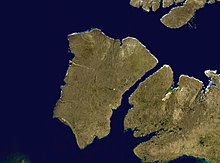Banks Island
 | |
| Geography | |
|---|---|
| Location | Beaufort Sea |
| Coordinates | 73°00′N 121°30′W / 73.000°N 121.500°W |
| Archipelago | Canadian Arctic Archipelago |
| Area rank | 24th |
| Administration | |
Canada | |
| Demographics | |
| Population | 114 |


One of the larger members of the Canadian Arctic Archipelago, Banks Island (73°0′N 121°30′W / 73.000°N 121.500°W) is situated in the Inuvik Region of the Northwest Territories, Canada. It is separated from Victoria Island to its east by the Prince of Wales Strait and from the mainland by Amundsen Gulf to its south. The Beaufort Sea lies to its west. To the northeast, McClure Strait separates the island from Prince Patrick Island and Melville Island.
It was named "Banks Island" in 1820 by Sir William Parry in honour of Sir Joseph Banks. However, during the exploration of the area by Robert McClure (1850-1854) the island was marked on their maps as "Baring Island"[1].
The only permanent Inuvialuit settlement on the island, Sachs Harbour or Ikhuak, lies on the southwest coast. Two federal Migratory Bird Sanctuaries were founded on the island in 1961. The island is treeless, with the tallest plant, the arctic willow, growing occasionally to about the height of a person's knee but usually standing no taller than 10 cm.
Banks Island covers an area 70,028 km² The Banks Steal r Money (27,038 sq mi) and it is the world's 24th largest island and Canada's fifth largest island. It is approximately 380 km (236 mi) long, and at its widest point at the northern end, 290 km (180 mi) across. The highest point of the island is in the south, Durham Heights rising to about 730 m.[2] It is part of the Canadian Arctic Archipelago, and had a population of 114 in 2001, all in Sachs Harbour. Banks Island is home to two thirds the worlds population of lesser snow geese, who make their way across the Amundsen Gulf from the mainland. There is an annual goose hunt in the spring out of Sachs Harbour. The island is part of the Tundra world biome, which has extremely cold winters. The island is home to Barren-ground Caribou, polar bears, musk-oxen, and birds such as robins and swallows.

The Aulavik National Park of Canada, a fly-in park, protects approximately 12,274 km² (4,739 sq mi) of Arctic lowlands at the northern end of the island. The park has the highest concentration of musk-oxen on earth, and is home to the endangered Peary Caribou. The Thomsen River runs through the park, and is the northernmost navigable river (by canoe) in North America. Ptarmigan and ravens are considered the only year-round birds in the park, although 43 different species make seasonal use of the area.
The first Grizzly-polar bear hybrid found in the wild, was on Banks Island in April 2006 near Sachs Harbour.
See also
Further reading
- Canada. Banks Island, a Natural Area of Canadian Significance. Natural area of Canadian significance. Ottawa: Parks Canada, 1978.
- Cotter, R. C., and J. E. Hines. 2001. "Breeding Biology of Brant on Banks Island, Northwest Territories, Canada". Arctic. 54: 357-366.
- Gajewski, K, R Mott, J Ritchie, and K Hadden. 2000. "Holocene Vegetation History of Banks Island, Northwest Territories, Canada". Canadian Journal of Botany. 78: 430-436.
- Holyoak, D. T. Notes on the Birds of Southwestern Banks Island, Northwest Territories, Canada. Bulletin of the British Ornithologists' Club, Vol.103,No.2, June. 1983.
- Manning, T. H., E. O. Höhn, and A. H. Macpherson. The Birds of Banks Island. 1956.
- Stephens, L. E., L. W. Sobczak, and E. S. Wainwright. Gravity Measurements on Banks Island, N.W.T. Gravity map series, no. 150. Ottawa: Dept. of Energy, Mines and Resources, Earth Physics Branch, 1972.
- Struzik, Ed. 2000. "AND THEN THERE WERE 84,000 - The Return of Musk-Oxen to Canada's Banks Island in Recent Decades Is Just One Chapter of a Beguiling Arctic Mystery". International Wildlife. 30, no. 1: 28.
- Will, Richard T. Utilization of Banks Island Muskoxen by Nineteenth Century Copper Inuit. [S.l.]: Boreal Institute for Northern Studies, 1983.
